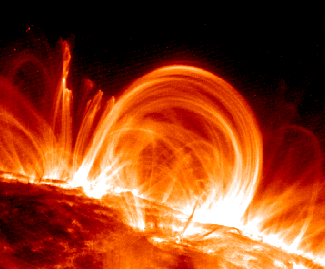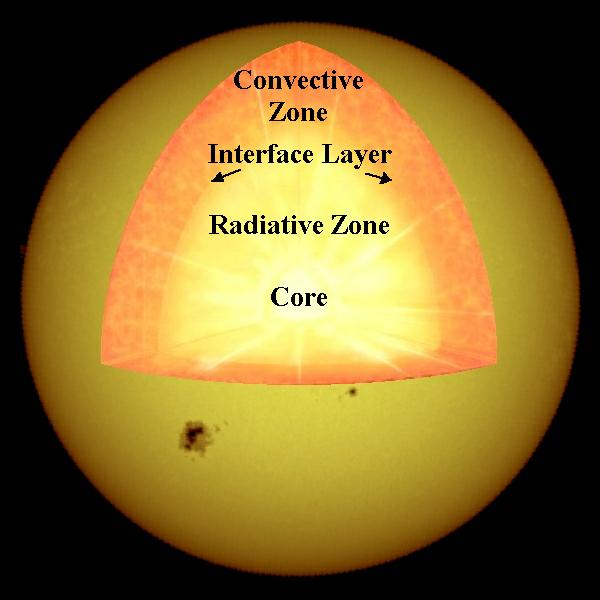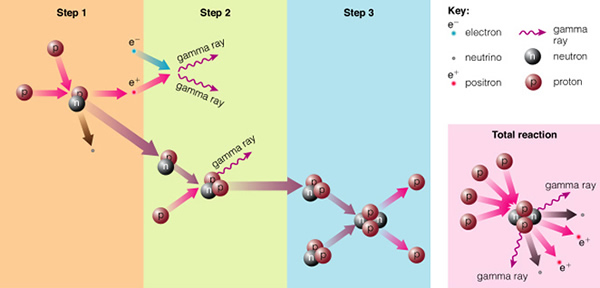|
|
|
|
|
| Solar Wind | Variable | >100 AU | 400-800 km/s |
| Corona | 3 million K | 0.15 AU (30 Rsun) | Highly dynamic loops |
| Chromosphere | 10,000 K | 2000 km above surface | Filaments, Plage |
| Photosphere | 6,000 K | Surface (1 Rsun) | Sunspots, Granulation |
| Convection Zone | 100,000 to several million K | 0.7 to 1 Rsun | Upward and downward motions |
| Radiation Zone | 10 million K | 0.2 to 0.7 Rsun | Energy carried by photons |
| Core | 15 million K | 0 to 0.2 Rsun | Region of nuclear fusion |
Solar Wind: Even at the distance of the Earth we can be said to be inside the Sun. Particles and magnetic fields from the Sun make up the solar wind, which blows past the Earth at speeds from 400-800 km/s (about 1 million mph!).
Corona: The source of the solar wind is the solar corona, which is the tenuous outer atmosphere of the Sun. The corona is very hot (several million K), and so it shines in X-rays and ultraviolet light, but also can be seen in visible light during an eclipse (it is too faint to see otherwise). The corona is highly dynamic, and looks different every time you look at it.

TRACE image of coronal loops in the UV
Chromosphere: This is a relatively thin layer that shows as pink during a solar eclipse, hence the name chromosphere, which means color sphere. Some of the strongest spectral lines from the Sun come from the chromosphere, and we can take pictures using the light in one of these lines. NJIT runs the Big Bear Solar Observatory, where we can see the latest images in the hydrogen alpha line. Here we see a number of features of the solar atmosphere, including filaments (dark clouds of hydrogen gas suspended above the surface) and prominences (same as filaments, but sticking out above the limb of the Sun) , sunspots (dark spots), and plage (bright areas around sunspots).
Photosphere: This is the visible surface of the Sun. It is called the photosphere because this is the point of the last scattering of photons before they escape directly into space. It has a remarkably uniform temperature of about 6000 K, except in small spots called sunspots that come and go with time. The sunspots are regions of high magnetic field, which inhibit the flow of heat from the hotter surroundings, so they are cooler (about 4000 K). This is why they appear dark. In fact, they only appear dark because they are seen against the brighter, hotter surroundings. If you could see them in isolation, they would glow brightly, and would be reddish in color. In fact, many stars have surfaces about 4000 K or less, and they emit plenty of light. If you look closely at the photosphere away from sunspots, you can see a fine convection pattern called granulation. Click here for a movie.
Convection Zone: Just beneath the photosphere, and extending inward to about 0.7 Rsun, is the convection zone. Energy generated in the core of the Sun moves outward through this layer by a boiling motion in which hot plasma rises, releases some of its energy, cools, and then sinks again. This entire layer of the Sun overturns on a timescale of months. The convection cells in this layer are far larger than the surface granulation, and become turbulent due to the low viscosity and the rotation of the Sun.

Radiation Zone: Deeper into the Sun, the plasma suddenly becomes smoother and the turbulence disappears. From here all the way to the core, energy is not transported by boiling motions, but directly by radiation. The photons kind of percolate through the layer, going a short distance, interacting with an atom, changing direction, going a short distance, slowly diffusing outward in a random walk. It takes a photon about 1 million years to traverse this layer!
The Core: The core of the Sun is where the temperature is high enough for active nuclear fusion. That is where hydrogen, the nuclear fuel, is being converted to helium. The core is the only place in the Sun where significant energy is being generated.
